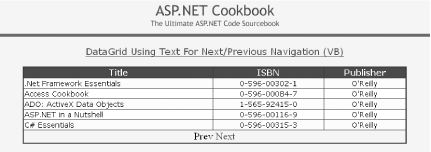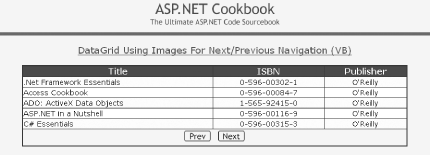You need to display data from a database in a table, but the database has more rows than can fit on a single page so you want to use next/previous buttons for navigation.
Use a DataGrid control, enable its built-in
pagination features, and then bind the data to it.
Add a DataGrid control to the
.aspx file, and use its
AllowPaging and other related attributes to enable
pagination.
In the code-behind class for the page, use the .NET language of your choice to:
Create a routine that binds a
DataSetto theDataGridin the usual fashion.Create an event handler that performs the page navigation—for example, one that handles the
PageIndexChangedevent for theDataGrid—and rebinds the data.
Figure 1-6 shows the appearance of a typical
DataGrid within a browser with next/previous
navigation. Example 1-17 through Example 1-19 show the .aspx and
code-behind files for an application that produces this result.
The DataGrid control includes the ability to
perform pagination of the data that is displayed in the grid, and
using the built-in pagination requires very little code. Pagination
is enabled and configured by the attributes of the
DataGrid element:
AllowPaging="True" PageSize="5" PagerStyle-Mode="NextPrev" PagerStyle-Position="Bottom" PagerStyle-HorizontalAlign="Center" PagerStyle-NextPageText="Next" PagerStyle-PrevPageText="Prev">
Setting the AllowPaging attribute to
True enables paging for the
DataGrid, and the PageSize
attribute defines the number of rows that will be displayed in a
single page. Setting the PageStyle-Mode attribute
to NextPrev enables the output of the
Next/Prev controls (see
Recipe 1.9 for other uses of this attribute).
The remaining attributes define how the pagination controls look.
PageStyle-Position defines the location of the
Next/Prev controls. Valid
values include Bottom, Top, and
TopAndBottom.
PagerStyle-HorizontalAlign defines the horizontal
positioning of the Next/Prev
controls. Valid values include Left,
Center, Right, and
NotSet. NotSet is effectively
the same as Left because Left
is the default.
PagerStyle-NextPageText defines the text to output
for the next page navigation control, and
PagerStyle-PrevPageText defines the text to output
for the previous page navigation.
Tip
The PagerStyle-NextPageText and
PagerStyle-PrevPageText attribute values can
include HTML to format the text of the controls. Virtually any HTML
can be used, including image tags. If you change the values of the
two text attributes, the
Next/Prev controls will be
output, as shown in Figure 1-7.
PagerStyle-NextPageText=
"<img src='images/buttons/button_next.gif'
border='0'>"
PagerStyle-PrevPageText=
"<img src='images/buttons/button_prev.gif'
border='0'>">The bindData routine, shown in the code-behind in
Example 1-18 (VB) and Example 1-19
(C#), performs the data binding. This routine provides the typical
binding of a dataset to the DataGrid. No
additional code is required in this routine to support the default
pagination.
The dgBooks_PageIndexChanged event handler
provides the code required to perform the page navigation. The new
page number to display is passed in the event arguments
(e). The CurrentPageIndex
property of the DataGrid must be set to the passed
value, and the data must be rebound to the
DataGrid.
Tip
The default pagination code shown in this recipe can be very
inefficient when used with data containing a large number of rows. By
default, all of the data for a query is returned and used to populate
the DataSet. When the query returns a relatively
small set of data (less than 100 rows and a small number of columns),
the pagination shown in this recipe is adequate for most
applications. If your query returns a million rows, the performance
of your application will be unacceptable. See Recipe 1.10 for a more efficient approach to the
pagination of large datasets.
Recipe 1.8, Recipe 1.9, and Recipe 1.10 for other examples of pagination
Example 1-17. DataGrid with next/previous navigation (.aspx)
<%@ Page Language="vb" AutoEventWireup="false"
Codebehind="CH01DatagridWithNextPrevNavVB1.aspx.vb"
Inherits="ASPNetCookbook.VBExamples.CH01DatagridWithNextPrevNavVB1" %>
<!DOCTYPE HTML PUBLIC "-//W3C//DTD HTML 4.0 Transitional//EN">
<html>
<head>
<title>Datagrid With Text For Next/Prev Navigation</title>
<link rel="stylesheet" href="css/ASPNetCookbook.css">
</head>
<body leftmargin="0" marginheight="0" marginwidth="0" topmargin="0">
<form id="frmData" method="post" runat="server">
<table width="100%" cellpadding="0" cellspacing="0" border="0">
<tr>
<td align="center">
<img src="images/ASPNETCookbookHeading_blue.gif">
</td>
</tr>
<tr>
<td class="dividerLine">
<img src="images/spacer.gif" height="6" border="0"></td>
</tr>
</table>
<table width="90%" align="center" border="0">
<tr>
<td><img src="images/spacer.gif" height="10" border="0"></td>
</tr>
<tr>
<td align="center" class="PageHeading">
DataGrid Using Text For Next/Previous Navigation (VB)
</td>
</tr>
<tr>
<td><img src="images/spacer.gif" height="10" border="0"></td>
</tr>
<tr>
<td align="center">
<asp:DataGrid
id="dgBooks"
runat="server"
BorderColor="000080"
BorderWidth="2px"
AutoGenerateColumns="False"
width="100%"
AllowPaging="True"
PageSize="5"
PagerStyle-Mode="NextPrev"
PagerStyle-Position="Bottom"
PagerStyle-HorizontalAlign="Center"
PagerStyle-NextPageText="Next"
PagerStyle-PrevPageText="Prev">
<HeaderStyle HorizontalAlign="Center"
ForeColor="#FFFFFF"
BackColor="#000080"
Font-Bold=true
CssClass="TableHeader" />
<ItemStyle BackColor="#FFFFE0"
cssClass="TableCellNormal" />
<AlternatingItemStyle BackColor="#FFFFFF"
cssClass="TableCellAlternating" />
<Columns>
<asp:BoundColumn HeaderText="Title" DataField="Title" />
<asp:BoundColumn HeaderText="ISBN" DataField="ISBN"
ItemStyle-HorizontalAlign="Center" />
<asp:BoundColumn HeaderText="Publisher" DataField="Publisher"
ItemStyle-HorizontalAlign="Center" />
</Columns>
</asp:DataGrid>
</td>
</tr>
</table>
</form>
</body>
</html>Example 1-18. DataGrid with next/previous navigation code-behind (.vb)
Option Explicit On
Option Strict On
'-----------------------------------------------------------------------------
'
' Module Name: CH01DatagridWithNextPrevNavVB1.aspx.vb
'
' Description: This class provides the code behind for
' CH01DatagridWithNextPrevNavVB1.aspx
'
'*****************************************************************************
Imports Microsoft.VisualBasic
Imports System.Configuration
Imports System.Data
Imports System.Data.OleDb
Namespace ASPNetCookbook.VBExamples
Public Class CH01DatagridWithNextPrevNavVB1
Inherits System.Web.UI.Page
'controls on form
Protected WithEvents dgBooks As System.Web.UI.WebControls.DataGrid
'*************************************************************************
'
' ROUTINE: Page_Load
'
' DESCRIPTION: This routine provides the event handler for the page load
' event. It is responsible for initializing the controls
' on the page.
'-------------------------------------------------------------------------
Private Sub Page_Load(ByVal sender As System.Object, _
ByVal e As System.EventArgs) _
Handles MyBase.Load
If (Not Page.IsPostBack) Then
bindData( )
End If
End Sub 'Page_Load
'*************************************************************************
'
' ROUTINE: dgCustomers_PageIndexChanged
'
' DESCRIPTION: This routine provides the event handler for the page
' index changed event of the datagrid. It is responsible
' for setting the page index from the passed arguments and
' rebinding the data.
'-------------------------------------------------------------------------
Private Sub dgBooks_PageIndexChanged(ByVal source As Object, _
ByVal e As System.Web.UI.WebControls.DataGridPageChangedEventArgs) _
Handles dgBooks.PageIndexChanged
'set new page index and rebind the data
dgBooks.CurrentPageIndex = e.NewPageIndex
bindData( )
End Sub 'dgCustomers_PageIndexChanged
'*************************************************************************
'
' ROUTINE: bindData
'
' DESCRIPTION: This routine queries the database for the data to
' displayed and binds it to the datagrid
'-------------------------------------------------------------------------
Private Sub bindData( )
Dim dbConn As OleDbConnection
Dim da As OleDbDataAdapter
Dim dSet As DataSet
Dim strConnection As String
Dim strSQL As String
Try
'get the connection string from web.config and open a connection
'to the database
strConnection = _
ConfigurationSettings.AppSettings("dbConnectionString")
dbConn = New OleDb.OleDbConnection(strConnection)
dbConn.Open( )
'build the query string and get the data from the database
strSQL = "SELECT Title, ISBN, Publisher " & _
"FROM Book " & _
"ORDER BY Title"
da = New OleDbDataAdapter(strSQL, dbConn)
dSet = New DataSet
da.Fill(dSet)
'set the source of the data for the datagrid control and bind it
dgBooks.DataSource = dSet
dgBooks.DataBind( )
Finally
'cleanup
If (Not IsNothing(dbConn)) Then
dbConn.Close( )
End If
End Try
End Sub 'bindData
End Class 'CH01DatagridWithNextPrevNavVB1
End NamespaceExample 1-19. DataGrid with next/previous navigation code-behind (.cs)
//----------------------------------------------------------------------------
//
// Module Name: CH01DatagridWithNextPrevNavCS1.aspx.cs
//
// Description: This class provides the code behind for
// CH01DatagridWithNextPrevNavCS1.aspx
//
//****************************************************************************
using System;
using System.Configuration;
using System.Data;
using System.Data.OleDb;
using System.Web.UI.WebControls;
namespace ASPNetCookbook.CSExamples
{
public class CH01DatagridWithNextPrevNavCS1 : System.Web.UI.Page
{
// controls on form
protected System.Web.UI.WebControls.DataGrid dgBooks;
//************************************************************************
//
// ROUTINE: Page_Load
//
// DESCRIPTION: This routine provides the event handler for the page
// load event. It is responsible for initializing the
// controls on the page.
//
//------------------------------------------------------------------------
private void Page_Load(object sender, System.EventArgs e)
{
// wire in the page index changed event
this.dgBooks.PageIndexChanged +=
new DataGridPageChangedEventHandler(this.dgBooks_PageIndexChanged);
if (!Page.IsPostBack)
{
bindData( );
}
} // Page_Load
//************************************************************************
//
// ROUTINE: dgCustomers_PageIndexChanged
//
// DESCRIPTION: This routine provides the event handler for the page
// index changed event of the datagrid. It is responsible
// for setting the page index from the passed arguments
// and rebinding the data.
//
//------------------------------------------------------------------------
private void dgBooks_PageIndexChanged(Object source,
System.Web.UI.WebControls.DataGridPageChangedEventArgs e)
{
// set new page index and rebind the data
dgBooks.CurrentPageIndex = e.NewPageIndex;
bindData( );
} // dgCustomers_PageIndexChanged
//************************************************************************
//
// ROUTINE: bindData
//
// DESCRIPTION: This routine queries the database for the data to
// displayed and binds it to the repeater
//
//------------------------------------------------------------------------
private void bindData( )
{
OleDbConnection dbConn = null;
OleDbDataAdapter da = null;
DataSet dSet = null;
String strConnection = null;
String strSQL =null;
try
{
// get the connection string from web.config and open a connection
// to the database
strConnection =
ConfigurationSettings.AppSettings["dbConnectionString"];
dbConn = new OleDbConnection(strConnection);
dbConn.Open( );
// build the query string and get the data from the database
strSQL = "SELECT Title, ISBN, Publisher " +
"FROM Book " +
"ORDER BY Title";
da = new OleDbDataAdapter(strSQL, dbConn);
dSet = new DataSet( );
da.Fill(dSet, "Table");
// set the source of the data for the datagrid control and bind it
dgBooks.DataSource = dSet;
dgBooks.DataBind( );
} // try
finally
{
//clean up
if (dbConn != null)
{
dbConn.Close( );
}
} // finally
} // bindData
} // CH01DatagridWithNextPrevNavCS1
}Get ASP.NET Cookbook now with the O’Reilly learning platform.
O’Reilly members experience books, live events, courses curated by job role, and more from O’Reilly and nearly 200 top publishers.



